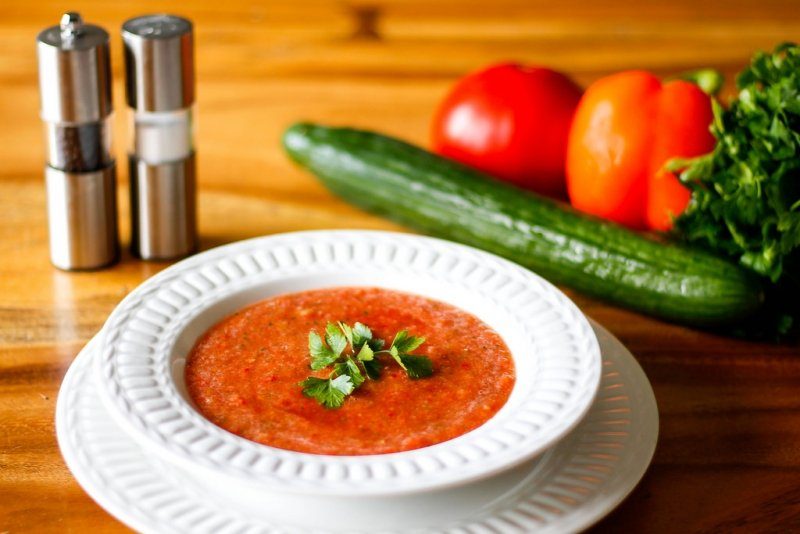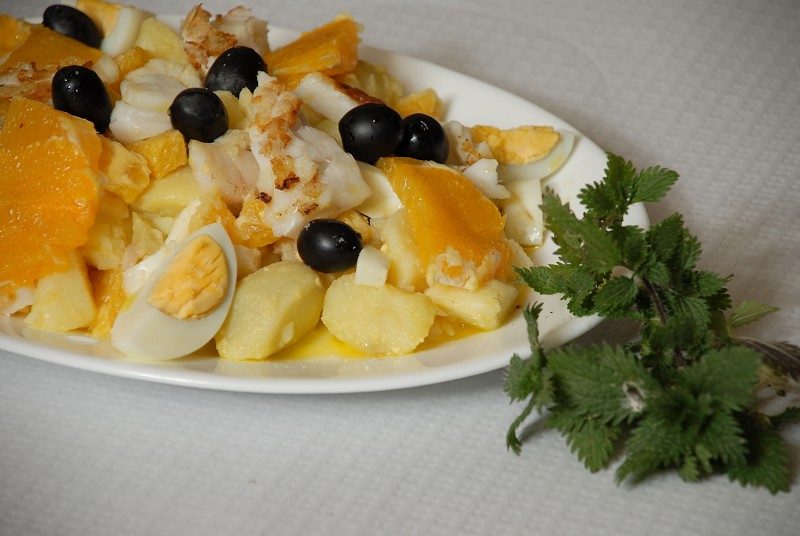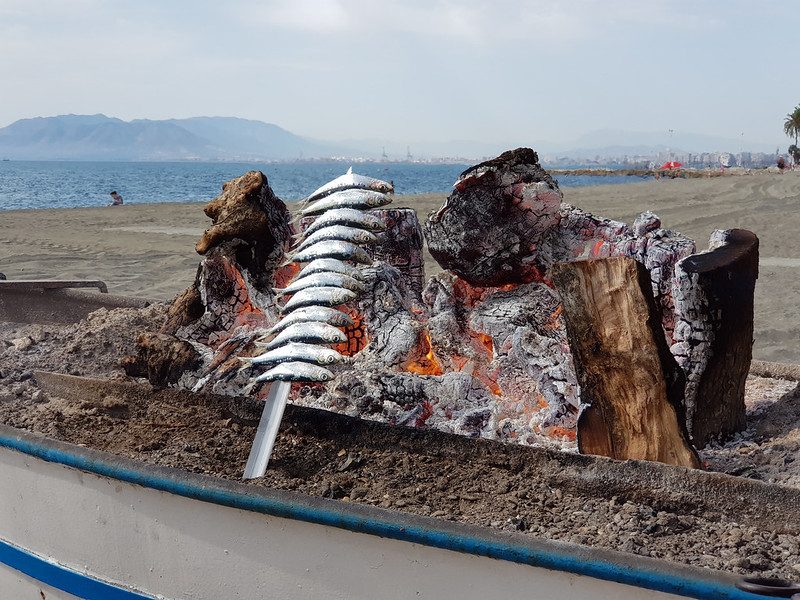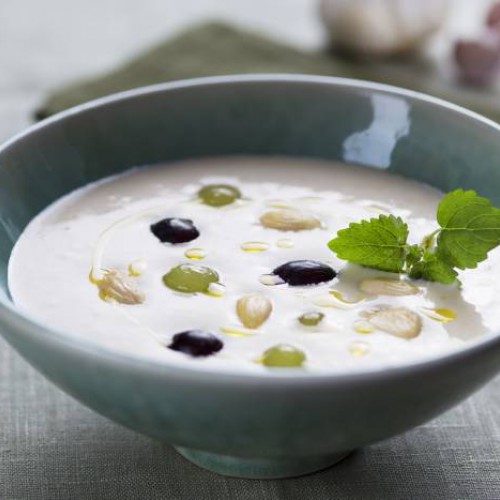Algunos ya estamos llegando tarde a la operación bikini. Asúmelo. Estamos a mediados de junio y lo que ya no hayas hecho durante todo el invierno y la primavera, no lo vas a lograr. Sin embargo, si lo que te gusta es llevar una alimentación sana y equilibrada y además aprovecharla para combatir el calor veraniego de Málaga, este es tu post. Presta atención a nuestro menú para un día de verano cualquiera. Juntamos en un nuevo artículo de nuestro blog salud y cómo combatir el calor disfrutando de la mejor gastronomía: La de la Costa del Sol.
GAZPACHO
De primero, gazpacho. Mítico, delicioso, fresco y saludable. Lo tiene todo. Esta sopa de tomate y hortalizas, tan typical spanish, lleva décadas asombrando a extranjeros y recopilando fieles seguidores día a día. Podemos contarte sobre él lo que ya sabes: Es una bebida fría compuesta por tomate, pepino, pimiento, cebolla, ajo, sal, aceite y vinagre. Algunos se atreven a echarle un chorro de limón e incluso pan. Pero como nos gusta ir siempre un paso más lejos, hemos estado investigando sobre el origen de esta popular exquisitez.
Esta sopa ha ido evolucionando a lo largo de su longeva vida (ya que sus orígenes datan del Siglo VIII, en Al-Ándalus durante el dominio musulmán en la península). En aquel entonces se componía básicamente de pan remojado en agua, ajo, almendras, aceite y vinagre. La primera referencia al gazpacho actual, tal y como lo conocemos, nos lleva al siglo XVI, cuando llegaron de América los tomates y los pimientos. Era la fuente principal de alimentación de los campesinos andaluces. Y sorprende que pudieran soportar durante tantas horas seguidas el duro trabajo campestre. A nivel de nutrientes, el gazpacho proporciona todas las vitaminas que pueden aportar las hortalizas ( ), hidratos de carbono si se utiliza pan como ingrediente…
Más adelante, durante el siglo XIX el plato se extendió a la burguesía, que se inventó la guarnición compuesta por pequeños trozos de hortalizas, para acompañarlo y darle otro toque diferente.
Sea como fuere (y con los matices que cada uno libremente quiera aportar a dicho plato) esta popular, exitosa y tradicional bebida perdurará durante mucho tiempo en la gastronomía española (y sobre todo en la andaluza).

ENSALADA MALAGUEÑA
Como acompañamiento, a modo de ración para compartir. Otro excelente as en la baraja de la gastronomía malagueña es nuestra ensalada. Sin lechuga. Es un combinado sabroso de patatas, naranja, cebolleta, pescado (atún o bacalao), aceitunas negras, huevo cocido, aceite, vinagre y sal. Como curiosidad, en algunas localidades de la provincia la denominan “ensalada cateta”. Incluso en determinados pueblos, este plato tiene diferentes variantes. Por ejemplo, en Torrox se llama ensalada arriera y lleva tomate. Incluso en Alhaurín El Grande no lleva ni atún ni pescado y se la denomina Mojete alhaurino. Es sencilla de preparar, sana, fresca, económica y nutritiva. De origen humilde, emplea productos de la tierra para combinarlos en un plato que, aunque es típico de invierno, su ligereza hace que sea idónea para comerla en verano.

ESPETOS
El plato estrella. ¿Qué hay más veraniego y malagueño que comerse unos deliciosos espetos en el chiringuito de la playa? Los conoces perfectamente. Son unas “brochetas” de sardinas hechas al fuego en una barca preparada con brasas
Su origen se remonta al siglo XIX. No hay que tener una ingeniería para saber que Málaga ha vivido fundamentalmente de la pesca. Las sardinas eran un alimento para gente humilde debido a su bajo coste. El espeto nace en un barrio de pescadores llamado El Palo. En 1882 Miguel Martínez Soler abrió en la playa un famoso bar conocido como “La gran parada”. Fue el pionero de los chiringuitos en la provincia y además, sería el que empezase a pinchar sardinas para cocinarlas al fuego, en la arena del litoral malagueño. Una forma de cocinar las sardinas que se ha transmitido de generación en generación a los llamados “amoragadores”
El historiador Fernando Rueda describe el momento en el que el Rey descubrió los espetos. Cuando en 1885 Alfonso XII visitó este legendario restaurante por motivo de un viaje oficial que realizó a la provincia de Málaga (por un terremoto en la Axarquía), se pasó por “La gran parada”. En el momento que Miguel le ofreció uno de sus espetos y se los sirvió, su Majestad se dispuso a comerlo con cuchillo y tenedor, a lo que Miguel le instó a comérselos con las manos.
Como curiosidad, los malagueños dicen que las mejores fechas para degustar los espetos son aquellos meses que no contienen la letra “R” en su nombre (mayo, junio, julio y agosto).

AJOBLANCO
Y de postre ajoblanco. Si no eres de Málaga probablemente te sorprenda que esta sopa blanca y fría de almendras, aceite, vinagre y ajo se consuma de postre. Pero lo cierto es que es así. Su intenso sabor gracias al ajo y vinagre y el amargor de las almendras marida a la perfección con frutas como el melón y las uvas.

------------------------------------------------------------------------------------------------------------------------------------------------------------------------------------------------------------------------------------------------
FOUR DISHES MALAGUEÑOS TO COMBAT THE HEAT
Some of us are already late for the bikini operation. Assume it We are in mid-June and what you have not done all winter and spring, you will not achieve. However, if what you like is to take a healthy and balanced diet and also take advantage of it to combat the summer heat of Malaga, this is your post. Pay attention to our menu for any summer day. We put together a new article in our health blog and how to fight the heat while enjoying the best cuisine: La Costa del Sol.
GAZPACHO
First, gazpacho. Mythic, delicious, fresh and healthy. Has it all. This tomato and vegetable soup, so typical Spanish, has been surprising foreigners for decades and gathering loyal followers every day. We can tell you about what you already know: It is a cold drink composed of tomato, cucumber, pepper, onion, garlic, salt, oil and vinegar. Some dare to pour a lemon juice and even bread. But since we like to go one step further, we have been investigating the origin of this popular delicacy.
This soup has evolved throughout its long life (since its origins date from the VIII century, in Al-Andalus during the Muslim rule in the peninsula). At that time, it consisted basically of bread soaked in water, garlic, almonds, oil and vinegar. The first reference to the current gazpacho, as we know it, takes us to the 16th century, when tomatoes and peppers arrived from America. It was the main source of food for the Andalusian peasants. And it is surprising that they could endure the hard work of the country for so many hours in a row. At the level of nutrients, gazpacho provides all the vitamins that vegetables can provide (), carbohydrates if bread is used as an ingredient ...
Later, during the nineteenth century the dish was extended to the bourgeoisie, who invented the garrison composed of small pieces of vegetables, to accompany it and give it another different touch.
Whatever it is (and with the nuances that each one freely wants to contribute to this dish) this popular, successful and traditional drink will last for a long time in Spanish cuisine (and especially in the Andalusian)
MALAGUEÑA SALAD
As an accompaniment, as a ration to share. Another excellent ace in the Malaga gastronomy deck is our salad. No lettuce. It is a tasty combination of potatoes, orange, chives, fish (tuna or cod), black olives, boiled egg, oil, vinegar and salt. As a curiosity, in some localities of the province they call it "cateta salad". Even in certain towns, this dish has different variants. For example, in Torrox it is called arriera salad and it has tomato. Even in Alhaurín El Grande does not have tuna or fish and is called Mojete alhaurino. It is simple to prepare, healthy, fresh, economical and nutritious. Of humble origin, it uses products of the earth to combine them in a dish that, although it is typical of winter, its lightness makes it ideal to eat it in summer.
SPETS
The star dish. What is more summery and Malaga than eating some delicious espetos at the beach bar? You know them perfectly. They are some "skewers" of sardines made by fire in a boat prepared with embers
Its origin dates back to the 19th century. You do not have to have an engineering to know that Malaga has lived mainly from fishing. The sardines were a food for humble people due to its low cost. El espeto was born in a fishing district called El Palo. In 1882 Miguel Martínez Soler opened on the beach a famous bar known as "La gran parada". He was the pioneer of the chiringuitos in the province and, in addition, he would be the one who started sardines to cook them on the fire, in the sand of the Malaga coast. A way to cook sardines that has been transmitted from generation to generation to the so-called "amoragadores"
The historian Fernando Rueda describes the moment in which the King discovered the skewers. When in 1885 Alfonso XII visited this legendary restaurant because of an official trip he made to the province of Malaga (due to an earthquake in the Axarquía), he went through "The great stop". At the moment that Miguel offered him one of his espetos and served them, his Majesty prepared to eat it with a knife and fork, to which Miguel urged him to eat them with his hands.
As a curiosity, the people of Malaga say that the best dates to taste the espetos are those months that do not contain the letter "R" in their name (May, June, July and August)
WHITE GARLIC
And for dessert ajoblanco. If you're not from Málaga, you'll probably be surprised that this cold, white soup of almonds, oil, vinegar and garlic is eaten for dessert. But the truth is that it is so. Its intense flavor thanks to the garlic and vinegar and the bitterness of the almonds match perfectly with fruits such as melon and grapes.
------------------------------------------------------------------------------------------------------------------------------------------------------------------------------------------------------------------------------------------------
Fuentes / Sources:
http://www.tvbio.es/articulos/49-gazpacho-andaluz
https://www.directoalpaladar.com/recetario/ensalada-malaguena-receta
https://www.malagaenlamesa.com/ensaladas-tradicionales-puedes-20170721170902-nt.html
Views: 220


